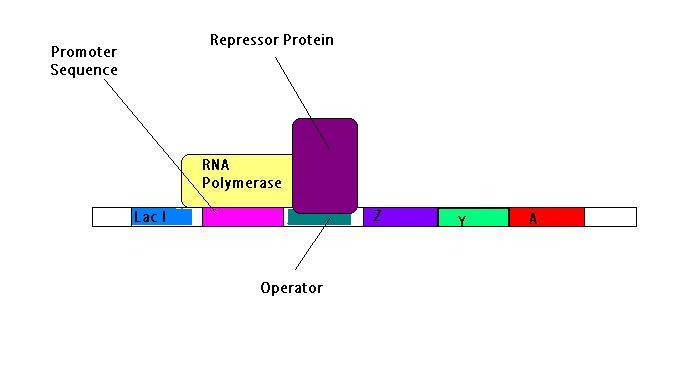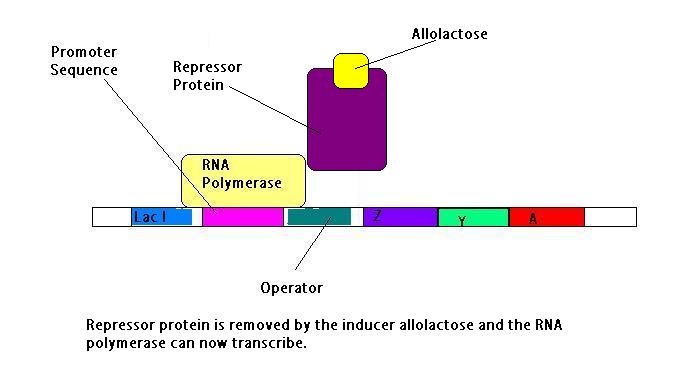The Lac Operon: Difference between revisions
Created page with '= The Lac Operon = == What is the Lac operon? == The lac operon is a good example of how genes are regulated. The lac operon was studied in E.coli.(1) It contains 3 genes that …' |
No edit summary |
||
| Line 13: | Line 13: | ||
== Negative gene regulation == | == Negative gene regulation == | ||
The conditions inside the cell are changing all the time. So what happens when glucose is present and lactose levels are low? The Lac operon is no longer required to make the proteins to break down lactose and so its function is switched off. This is done by the use of a repressor protein. (4)<br>Upstream of the promoter sequence there is another gene. This is the Lac I gene. The Lac I gene is transcribed to make the repressor protein which binds to the operator sequence.<br><br> | The conditions inside the cell are changing all the time. So what happens when glucose is present and lactose levels are low? The Lac operon is no longer required to make the proteins to break down lactose and so its function is switched off. This is done by the use of a repressor protein. (4)<br>Upstream of the promoter sequence there is another gene. This is the Lac I gene. The Lac I gene is transcribed to make the repressor protein which binds to the operator sequence. | ||
<br>[[Image:Lac_operon_-_with_lac_I_and_operator_seq.JPG|946x499px]]<br>[[Image:Lac_operon_-_with_lac_I_and_operator_seq_nd_repressor.JPG|895x474px]] | |||
Once the repressor protein is bound, it stops the RNA polymerase enzyme from transcribing the genes. Effectively, it acts as a block. (5) | |||
When the conditions in the cell change, the glucose levels deplete and the lactose levels rise, the repressor has to be removed in order to transcribe the required genes. This is done by an inducer molecule. This molecule comes from lactose and is Allolactose. This binds to the repressor protein and causes it to change, a conformational change. Once it has bound, the repressor can no longer bind to the operator sequence as it did before, its affinity has changed, and so is removed. RNA polymerase can work as it is not blocked and the Lac Z, Lac Y and Lac A genes are transcribed. (6) <br> | |||
[[Image:Lac_operon_-_allolactose.JPG]] | |||
== Positive Gene regulation == | |||
Sometimes promoters are not strong enough to initiate transcription on their own and so require another molecule or complex to help. In the Lac operon, this is done by the CRP – cAMP complex. <br>When glucose levels in the cell are low, the levels of cAMP build up.(7) This then combines with CRP and forms a complex. The complex can then join to the promoter sequence as well as the RNA polymerase and acts as a positive activator and encourages transcription. (8)<br>When the levels of glucose increase again, the amount of cAMP synthesised is reduced and so the complex levels decrease. This therefore inhibits the Lac operon from working.<br> | |||
Revision as of 18:33, 3 January 2011
The Lac Operon
What is the Lac operon?
The lac operon is a good example of how genes are regulated. The lac operon was studied in E.coli.(1) It contains 3 genes that are needed to produce proteins that are required to break down lactose when it is present in the cell. These 3 genes are Lac Z, Lac Y and Lac A. Each code for B- galactosidase, Permease and Transacetylase respectively. (2)
Further up the genetic code from these three genes, upstream, lies the promoter sequence. RNA polymerase needs a region in which it can join the genetic code, the promoter sequence, before it can start transcribing. RNA polymerase is required in transcription of the Lac operon. (3)
When does the Lac operon function?
The Lac operon does not function all the time and so has to be regulated. When lactose is present in the cell and glucose is absent, then the Lac operon is active and the 3 genes are transcribed to break down this lactose in the cell.
Negative gene regulation
The conditions inside the cell are changing all the time. So what happens when glucose is present and lactose levels are low? The Lac operon is no longer required to make the proteins to break down lactose and so its function is switched off. This is done by the use of a repressor protein. (4)
Upstream of the promoter sequence there is another gene. This is the Lac I gene. The Lac I gene is transcribed to make the repressor protein which binds to the operator sequence.
Once the repressor protein is bound, it stops the RNA polymerase enzyme from transcribing the genes. Effectively, it acts as a block. (5)
When the conditions in the cell change, the glucose levels deplete and the lactose levels rise, the repressor has to be removed in order to transcribe the required genes. This is done by an inducer molecule. This molecule comes from lactose and is Allolactose. This binds to the repressor protein and causes it to change, a conformational change. Once it has bound, the repressor can no longer bind to the operator sequence as it did before, its affinity has changed, and so is removed. RNA polymerase can work as it is not blocked and the Lac Z, Lac Y and Lac A genes are transcribed. (6)
Positive Gene regulation
Sometimes promoters are not strong enough to initiate transcription on their own and so require another molecule or complex to help. In the Lac operon, this is done by the CRP – cAMP complex.
When glucose levels in the cell are low, the levels of cAMP build up.(7) This then combines with CRP and forms a complex. The complex can then join to the promoter sequence as well as the RNA polymerase and acts as a positive activator and encourages transcription. (8)
When the levels of glucose increase again, the amount of cAMP synthesised is reduced and so the complex levels decrease. This therefore inhibits the Lac operon from working.



